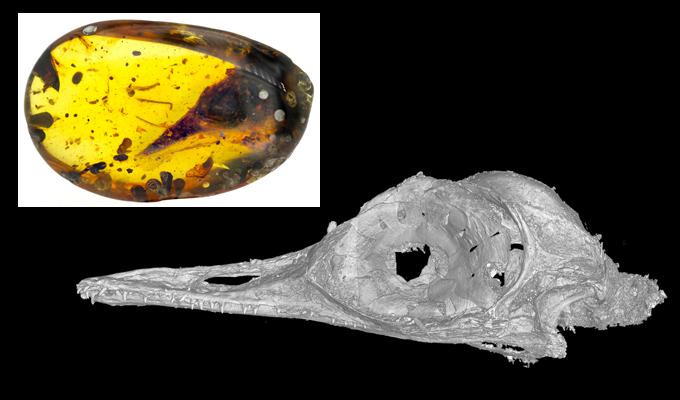A tiny, toothed bird that lived 99 million years ago appears to be the smallest known dinosaur from the Mesozoic Era. That era lasted from about 252 million to 66 million years ago. The creature’s skull was 12-millimeters (a half inch) long. It had been encased in a chunk of amber. That chunk was originally discovered in northern Myanmar in southeast Asia. Researchers reported the find March 11 in Nature.
Modern birds are the only dinosaurs still living today. The bee hummingbird is the smallest of those. The newfound species was about the same size. It’s been named Oculudentavis khaungraae. Researchers made 3-D images of its fossilized skull with computed tomography. That’s a type of X-ray imaging. Those scans revealed that the Mesozoic bird had little but size in common with today’s nectar-sipping hummingbirds.
The images reveal a surprising number of teeth. That suggests the tiny bird was a predator, the researchers report. “It had more teeth than any other Mesozoic bird, regardless of size,” says Jingmai O’Connor. She’s a paleontologist. She works at the Institute of Vertebrate Paleontology and Paleoanthropology in Beijing, China. As for its prey, researchers can only guess, she says. O. khaungraae probably dined on arthropods and other invertebrates. It may even have eaten small fish.
The ancient bird’s had deep, conical eye sockets. They are similar to those of modern predatory birds such as owls. Those deep sockets can increase the eye’s visual ability without increasing its diameter. This suggests the ancient birds had sharp eyesight, O’Connor says. Owls’ eyes face forward, increasing their depth perception. But the eyes of the tiny dino faced out to the sides.
Some species evolve smaller adult body sizes over time. This is known as evolutionary miniaturization. There are limits to how small an animal can get. “You have all these restrictions related to trying to fit sensory organs into a small body,” O’Connor says.
She considered the possibility that this ancient bird had undergone such a miniaturization. When she did, “a lot of really weird, inexplicable things about the specimen suddenly made sense,” she says. The bird has several oddities. They include strangely fused teeth and a pattern of fusion in its skull. These “can be explained by miniaturization,” she says.

The small size might also be related to island dwarfism. That’s when larger animals evolve to smaller body sizes over many generations. This can happen because their ranges are quite limited, such as when they are confined to an island. The researchers aren’t sure exactly where the chunk of amber containing the bird skull came from. But anecdotal evidence suggests it may have come from a region in Myanmar that millions of years ago was part of an island chain.
Although it’s just one fossil, the find can shed light on how its body evolved to such a small size, says Roger Benson. He’s also a paleontologist. He works at the University of Oxford in England. He wrote a separate commentary about the discovery. It was published in the same issue of Nature.
The earliest birds, such as Archaeopteryx, arose around 150 million years ago. This find suggests that the body size of birds were reaching their lower limit by 99 million years ago, he says.
Scientists still need to figure out where the new species belongs on the tree of life. And that’s difficult, given the bird’s bizarre features, O’Connor says. “It’s just a skull. There’s a lot you can’t say,” she says. “Who knows what new [fossils] might tell us.”